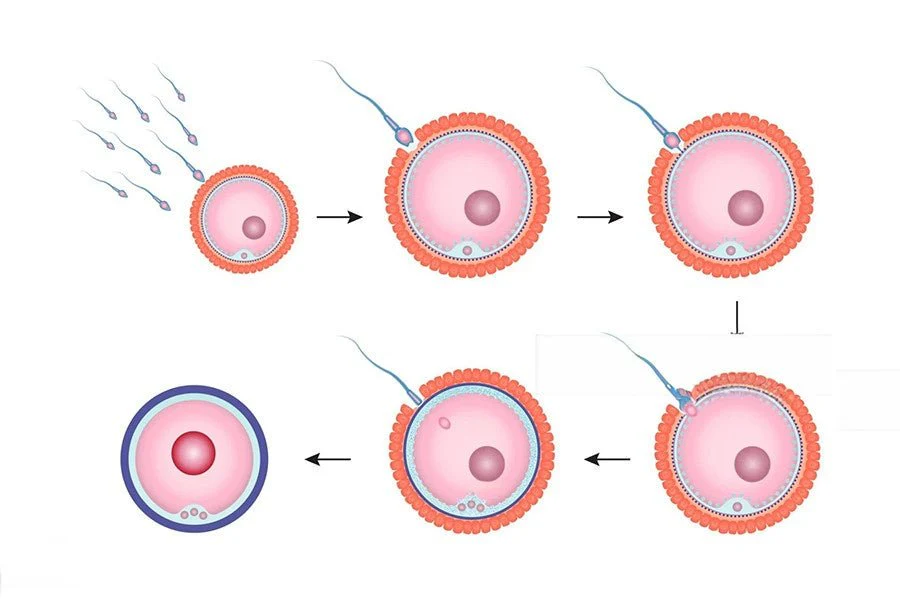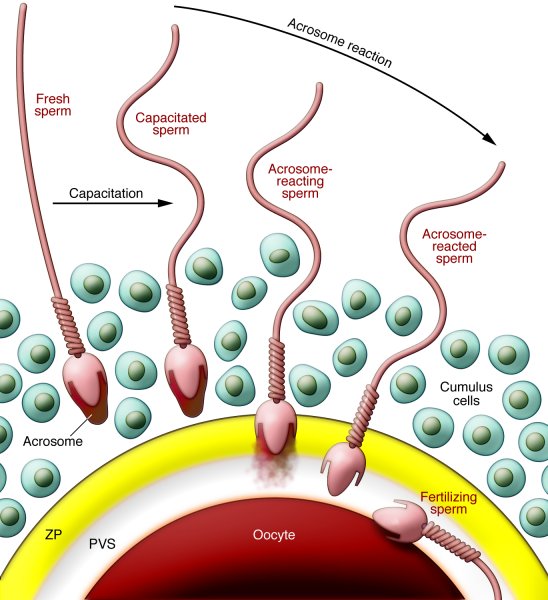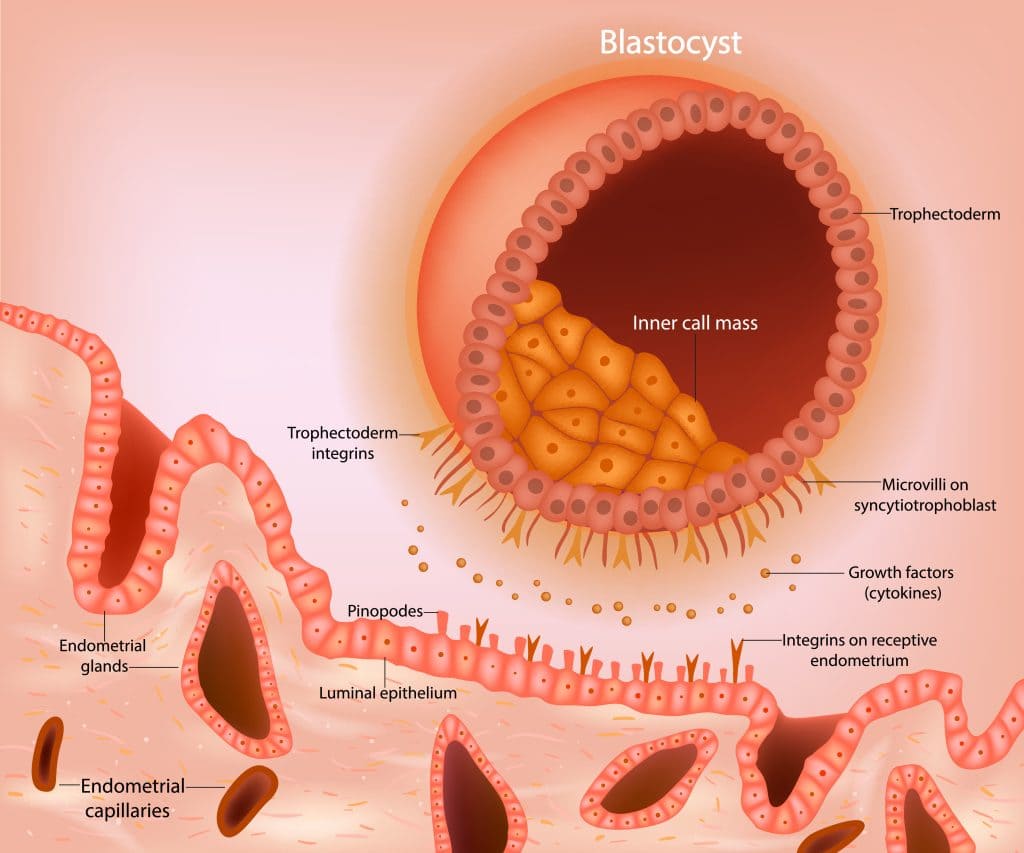Fertilization & Implantation: The Beginning of a New Individual

Fertilization
Fertilization, also known as conception, is the fundamental biological process where a male gamete (sperm) and a female gamete (secondary oocyte) fuse to form a new, single-celled entity called a zygote.
This remarkable union restores the diploid (2n) number of chromosomes and marks the very beginning of the development of a new, genetically unique individual.
Site of Fertilization
In humans, fertilization typically occurs in the ampulla of the fallopian tube (oviduct). This is the wider, outer portion of the tube, close to the ovary, where the egg is captured after ovulation.
The Key Players in Fertilization
Successful fertilization depends on the precise interaction of four critical components.
Sperm (Male Gamete)
A small, motile cell designed to travel through the female reproductive tract and deliver its haploid genetic material to the egg.
Egg (Secondary Oocyte)
A large, non-motile cell containing the female's haploid genetic material, cytoplasm, and all the necessary nutrients to support early embryonic development. It is arrested in Metaphase II of meiosis.
Zona Pellucida
A thick, glycoprotein-rich outer layer surrounding the egg. It acts as a species-specific binding site for sperm and is essential for preventing polyspermy (fertilization by more than one sperm).
Corona Radiata
The outermost layer of follicular (granulosa) cells that surrounds the zona pellucida, providing nourishment and protection to the ovulated egg.
The Journey of the Sperm
The passage of sperm through the female reproductive tract is a highly regulated and selective process, designed to ensure only sperm with normal morphology and vigorous motility reach the egg.
- Post-Ejaculation: Semen coagulates into a gel, protecting sperm from the vagina's acidic environment and holding them near the cervix. This gel liquefies within an hour.
- The Cervix: Cervical mucus acts as a barrier, filtering out sub-motile sperm.
- The Uterus: Uterine myometrial contractions, aided by prostaglandins in the seminal fluid, propel the sperm towards the fallopian tubes.
The first sperm enter the fallopian tubes minutes after ejaculation, but they can survive in the female reproductive tract for up to five days, awaiting ovulation.

The Events of Fertilization
Once an ovulated egg is present, fertilization proceeds through a highly coordinated series of events.
Event 1: Capacitation
A final maturation step that "arms" the sperm within the female reproductive tract.
The Process: The female tract's environment strips away cholesterol and proteins from the sperm's head.
The Result: The sperm's tail becomes hyper-motile, and its acrosome membrane is destabilized, ready to release enzymes.
Key takeaway: A sperm cannot fertilize an egg until it has been capacitated.
Event 2: The Acrosomal Reaction
Penetrating the Corona Radiata: Hyper-motile sperm push through the outer layer of follicular cells.
Binding to the Zona Pellucida: The sperm binds to species-specific ZP3 receptors on the zona pellucida, like a key in a lock.
Releasing Enzymes: This binding triggers the acrosome to release digestive enzymes (like acrosin).
Digesting a Path: These enzymes create a tunnel through the zona pellucida, allowing the sperm to reach the egg's cell membrane.
Events 3 & 4: The Blocks to Polyspermy
To prevent a lethal condition where more than one sperm fertilizes the egg, the oocyte deploys a two-stage defense system.
Fast Block (Immediate but Temporary)
The instant fusion of the first sperm triggers a rapid influx of sodium ions (Na⁺) into the oocyte, instantly changing the membrane's electrical charge to repel all other sperm.
Slow Block (Cortical Reaction - Permanent)
Sperm fusion also triggers a massive release of calcium ions (Ca²⁺) inside the oocyte. This causes cortical granules to release enzymes that destroy all ZP3 receptors and harden the zona pellucida, making it impenetrable.
The Fusion and Formation of the Zygote
Oocyte Completes Meiosis: The calcium wave also signals the secondary oocyte to complete Meiosis II, forming the mature ovum and a second polar body.
Fusion of Pronuclei (Syngamy): The male pronucleus (from the sperm) and the female pronucleus (from the ovum) swell and then fuse their genetic material.
The Result: A zygote is formed—a new, single cell with the restored diploid number of 46 chromosomes, containing genetic material from both parents.
Cleavage and Blastocyst Formation
Cleavage is the initial series of rapid mitotic cell divisions that a newly formed zygote undergoes immediately after fertilization. This process transforms the single-celled zygote into a multicellular structure ready for implantation.
Key Characteristics of Cleavage

The Stages of Cleavage: A Timeline
From Morula to Blastocyst
As the morula continues to divide, a fluid-filled cavity (the blastocoel) forms inside, transforming the solid ball into a more complex structure called the blastocyst. The cells reorganize into two distinct, crucial groups:
Inner Cell Mass (ICM)
A cluster of pluripotent cells at one end of the blastocoel. This group will form the actual embryo.
Trophoblast
The outer layer of cells surrounding the ICM and blastocoel. These cells are crucial for implantation and will form part of the placenta.
Around day 5-6, the blastocyst "hatches" from the zona pellucida, ready for implantation.

Formation of the Bilaminar Disc
Just as implantation begins, the Inner Cell Mass (ICM) differentiates into two critical layers, forming the bilaminar (two-layered) embryonic disc.
Epiblast (Upper Layer)
Faces the trophoblast. Crucially, all three primary germ layers (ectoderm, mesoderm, endoderm) arise from the epiblast. The entire fetus develops from this layer.
Hypoblast (Lower Layer)
Faces the blastocoel. Contributes to extraembryonic structures, primarily the yolk sac, and provides important signaling to the epiblast.
Purpose of Cleavage
- Increase Cell Number: To generate enough cells for future development.
- Prepare for Implantation: To form the trophoblast, which is essential for implanting in the uterus.
- Establish Basic Organization: To create the initial distinction between cells that will form the embryo (ICM) and cells that will form the placenta (trophoblast).
Implantation: The Embryo's Attachment to the Uterus
Implantation is the crucial process by which the early embryo, now at the blastocyst stage, attaches itself to and invades the inner lining of the uterus, the endometrium. This typically occurs around 6 to 12 days after fertilization.
Prerequisites for Successful Implantation
For implantation to occur, two main conditions must be perfectly met, creating a synchronized "dialogue" between the embryo and the uterus.
1. A Competent Blastocyst
The blastocyst must be well-developed and, most importantly, must have "hatched" from its protective zona pellucida. This hatching allows the trophoblast cells to make direct contact with the uterine lining.
2. A Receptive Endometrium
The uterine lining must be in its secretory phase, made thick and nutrient-rich by the hormone progesterone. This period of optimal readiness is known as the "implantation window."

The Process of Implantation
Implantation is an active, multi-step process involving intricate interactions between the blastocyst's trophoblast and the endometrial cells.
1. Apposition (Initial Contact)
The hatched blastocyst makes initial, loose contact with the endometrial lining, typically orienting itself with the Inner Cell Mass facing the endometrium.
2. Adhesion (Binding)
The trophoblast cells begin to tightly adhere to the endometrial cells using specific adhesion molecules, acting like a form of molecular "Velcro."
3. Invasion
Trophoblast Differentiation:
The trophoblast differentiates into two layers:
- Cytotrophoblast: The inner, cellular layer.
- Syncytiotrophoblast: The outer, multinucleated, highly invasive layer.
Burrowing into the Uterine Wall:
The syncytiotrophoblast produces enzymes that break down the endometrial tissue, allowing the blastocyst to burrow deeper and establish a connection with maternal blood vessels.
Embedding:
The blastocyst gradually becomes completely embedded within the endometrium, and the surface defect is repaired by the surrounding endometrial cells.
Gastrulation Next Page
Test Your Knowledge
Check your understanding of the concepts covered in this post.
1. Fertilization most commonly occurs in which part of the female reproductive tract?
- Uterus
- Ovary
- Vagina
- Fallopian tube (Uterine tube)
2. Which layer of the oocyte must a sperm penetrate first to reach the plasma membrane?
- Zona pellucida
- Corona radiata
- Cytoplasm
- Nucleus
3. The fusion of the sperm and oocyte plasma membranes triggers a series of events in the oocyte known collectively as:
- Capacitation
- Cortical reaction (or zona reaction)
- Acrosomal reaction
- Cleavage
4. What is the primary purpose of the cortical reaction (or zona reaction) following sperm entry into the oocyte?
- To prepare the oocyte for meiosis II.
- To stimulate the formation of the pronuclei.
- To prevent polyspermy (entry of multiple sperm).
- To initiate the first mitotic division (cleavage).
5. The single diploid cell formed immediately after the fusion of male and female pronuclei is called a:
- Morula
- Blastocyst
- Zygote
- Gastrula
6. The series of rapid mitotic divisions that the zygote undergoes without significant growth in overall size is called:
- Gastrulation
- Implantation
- Cleavage
- Organogenesis
7. By approximately day 3-4 after fertilization, the developing embryo typically forms a solid ball of 16 or more cells called a:
- Zygote
- Blastocyst
- Morula
- Gastrula
8. Which part of the blastocyst is primarily responsible for implanting into the uterine wall?
- Inner cell mass
- Blastocoel
- Trophoblast
- Zona pellucida
9. Implantation of the blastocyst into the uterine wall typically begins around how many days after fertilization?
- 1-2 days
- 3-4 days
- 6-7 days
- 10-12 days
10. What is the main source of nutrition for the early embryo (morula and early blastocyst) before implantation?
- Maternal blood directly
- Secretions from the uterine tubes and uterus (uterine milk)
- Yolk sac
- Placenta
11. Before a sperm can fertilize an oocyte, it must undergo a maturation process in the female reproductive tract called _____________.
12. The enzymes contained within the ___________ of the sperm are crucial for penetrating the oocyte's protective layers.
13. During cleavage, the individual cells of the developing embryo are called _____________.
14. The hollow, fluid-filled cavity inside the blastocyst is known as the _____________.
15. The inner cell mass of the blastocyst will eventually develop into the _____________.
Quiz Complete!
Your Score:
0%
0 / 0 correct